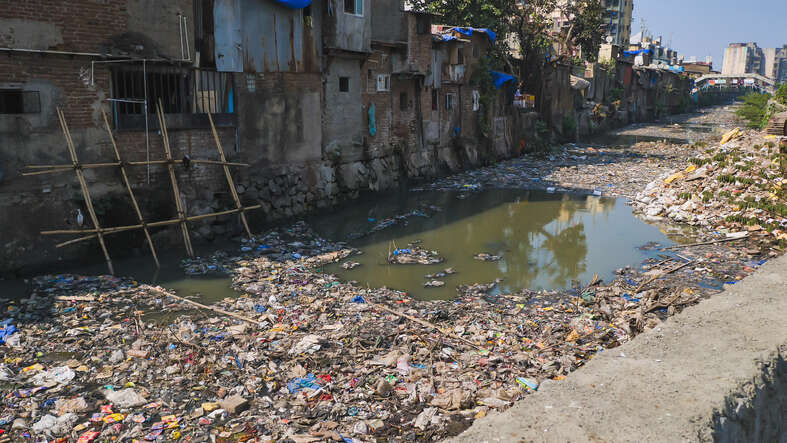
Last month, Chief Minister Bhagwant Mann drank a glass of water from the Kali Bein, a “holy river”, in order to show that it was clean. Two days later, he was hospitalised. This, believe it or not, was part of a campaign to show progress in cleaning water bodies. It illustrates, however, just how much work remains to be done in combating India’s water pollution.
Seventy per cent of the sewage that India generates is not treated. More than 4,000 septic trucks full of sludge are disposed of in the Ganges, its longest river, and its tributaries every day. Each truck would contain, on average, 5,000 litres of human waste. Perhaps what is more concerning is that the river basin has become the dumping ground for plastic garbage, including micro-plastics from face masks used during the pandemic.

According to ‘The Impact of Covid-19 on Plastic Waste Management in South Asia‘ by the World Bank, “The Indus and Ganges are among the world’s ten most polluted river systems in that they carry 90% of the plastic waste into the ocean.”
Water pollution in India is widespread
The Sri Lanka-based International Water Management Institute also states that India is a water stress zone, where 33% of its rivers are moderately or severely polluted.
Water pollution has infiltrated India’s state of Maharashtra, where a 2021 study conducted by ASAR Social Impact Advisors, a Bangalore-based consultancy, and two local research centres, the Center for Sustainable Development in Nagpur and Manthan Adhyayan Kendra in Pune, found toxic metals, such as mercury and arsenic, in surface and groundwater in 25 locations around fast-growing Nagpur.
High levels of fluoride, which cause teeth discolouration and potentially other health concerns, have already been reported in the groundwater of Amravati-Nagpur and the coastal South Konkan, where 93% of the residents depend on it for daily consumption. The researchers stated that their focus is different from others – on the water contamination at the power plants and not on the much-studied effects on air, like at Koradi and Khaparkheda.
The culprit seems to be coal combustion, which is used to produce 70% of the country’s electricity. It creates fly ash, which is typically kept in ash ponds that, due to their constructed dikes, sometimes spill into surrounding farms, fields and bodies of water. In Nagpur, this water is used by the locals for “drinking (with or without treatment)… domestic use, bathing, washing clothes, fishing, irrigation, and water for cattle”, according to the report, ‘Polluted Power: How Koradi And Khaperkheda Thermal Power Stations Are Impacting the Environment.
[Read more: Mumbai shows its strength in diversity]
Over the long term, crops will be destroyed and people who breathe in polluted air or ingest dirtied water may become sick.
The results, reported by the Indian Express, a Noida-based newspaper, found that almost “every water sample in every season, including monsoon, failed to pass the standards set for drinking water by the Bureau of Indian Standards… and other relevant standards with the sole exception of samples from Water ATM (an automatic water dispensing system) output.” The level of toxic metals surpassed the acceptable level by as much as 15 times.
Industrial corridor offers a glimpse into Mumbai’s water vulnerability
The development of the Delhi-Mumbai Industrial Corridor – and at least 18 more like it if the advice of McKinsey, a consultancy, is heeded – will create a tremendous need for clean water in India. The demographic boom alone warrants it; the population there will increase from 231 million in 2009 to 524 million in 2039. The groundwater level is already on the decline in 56% of the country. Currently, water demand in the corridor is shared by farmers (83%), industries (10%) and cities (7%).
The importance and – in all likelihood – inevitability of India’s urbanisation cannot be understated. The country’s cities will contribute 70% of the national GDP in 2030, up from 58% in 2008.
The recommendation comes from McKinsey’s report, ‘India’s Urban Awakening‘, which suggested back in 2010 that 20 to 25 cities be built to “support” the metropolises, ensuring that they, too, have access to adequate clean water, electricity and transportation. In the corridor, approximately one-third of the water supply will come from groundwater aquifers that are already polluted or severely depleted. The rest will come from rivers like the Tapi, which runs through northern Maharashtra, that are, in many cases, also overdrawn.
The need for economic and environmental self-sufficiency, further constrained by the reality of climate change, may only make clean water scarcer in Mumbai.
The city depends on its seven lakes – Bhatsa, Middle Vaitarna, Upper Vaitarna, Tansa, Modak Sagar, Tulsi and Vihar – for drinking water. It draws 3.9 billion litres of water from them every day, and the total supply, stored in 27 service reservoirs, can only last its residents 49 days. Bhatsa is the largest body of water among them and supplies to the nearby cities of Thane and Bhiwandi.
India’s water pollution threatens the economic and physical well-being of the 20 million-plus Mumbaikars, the way drinking contaminated water every day cannot sustain a person’s good health.
[Read more: How can cities improve air pollution after Covid-19?]






